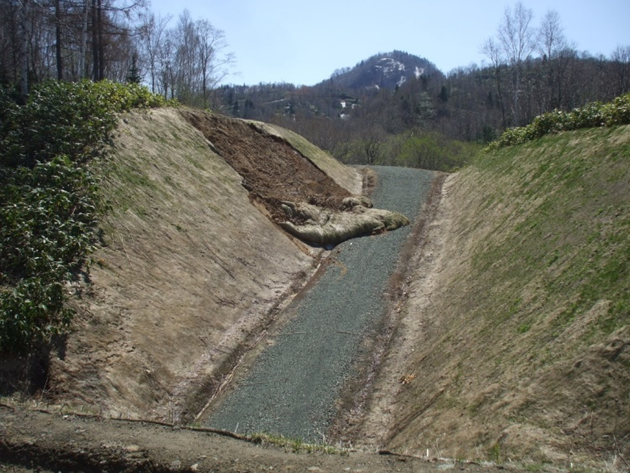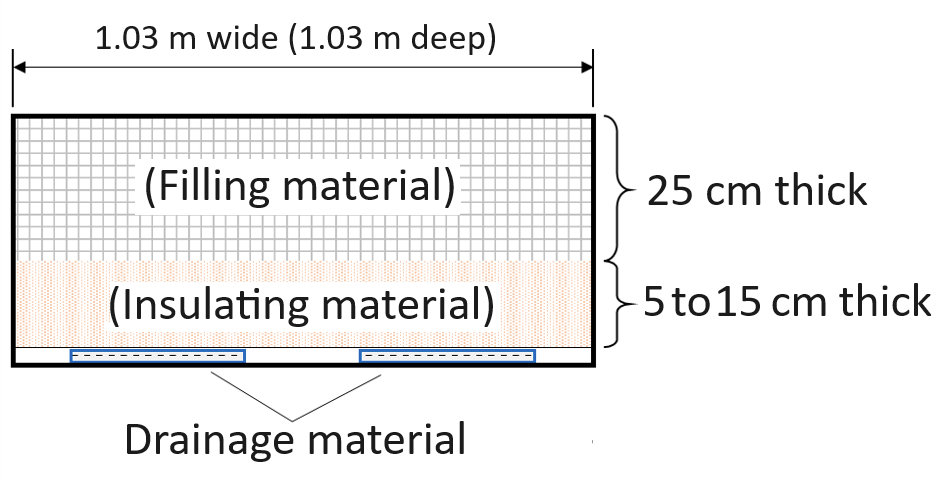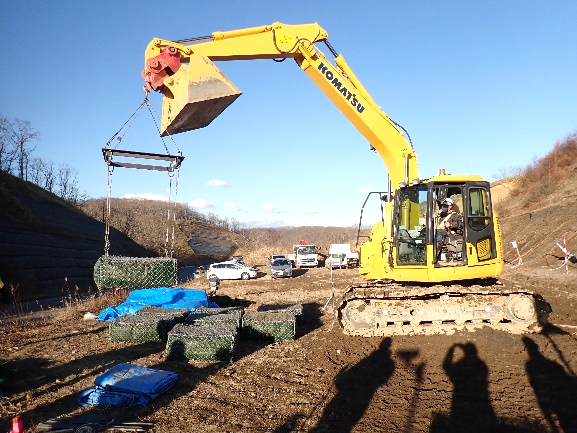Publication of the Manual on Measures for Rocks and Soils Bearing Natural Heavy Metals in Construction Works (2023 Edition)

Table 1 Major revisions to the manual

Photo 1 Brownish-colored slope with
poor vegetation growth
due to acidic water generation
from rocks
Rocks and soil (hereinafter collectively referred to as “soil”) may naturally contain trace amounts of substances (such as heavy metals*) that are harmful to the human body. Against the backdrop of heightened public awareness of the environment and enforcement of the Soil Contamination Countermeasures Act in 2003, there has been a growing demand to evaluate the impact of soil containing natural heavy metals on human health when implementing construction work, and to take the necessary measures. Meanwhile, since the generated soil is also a resource, effective utilization of soil containing natural heavy metals has also become an issue.
Therefore, a committee established by MLIT published the Manual on Measures for Rocks and Soils Bearing Natural Heavy Metals in Construction Works (provisional edition)1) in March 2010. The manual (provisional edition) provides methods to properly evaluate soil containing heavy metals and effectively use it as fill, for example, by implementing necessary countermeasures.
Since then, many field and research results have been accumulated, and after deliberation by a committee re-established by MLIT, the Manual on Measures for Rocks and Soils Bearing Natural Heavy Metals in Construction Works (2023 edition)2) was published on the MLIT website in March 2023. As with the previous edition, PWRI staff participated in the preparation of the revised manual as committee members, and the results of our research and technical guidance were reflected in the content of the revised manual.
In large-scale construction projects, the handling of generated soil is one of the major factors that determine the overall construction cost and time frame of the project. We hope that the manual (2023 edition) will contribute to rational business promotion.
Among the harmful substances designated by the Soil Contamination Countermeasures Act, cadmium, hexavalent chromium, mercury, selenium, lead, arsenic, fluorine, and boron, which are present in natural rocks and soil, are collectively referred to as “heavy metals” herein.
Major revisions to the manual (2023 edition)
The main revisions of this manual (Table 1) are as follows. For more detailed information, please refer to the manual (2023 edition).
References
https://www.mlit.go.jp/sogoseisaku/region/recycle/d03project/index_0305manual.htm
https://www.mlit.go.jp/sogoseisaku/region/recycle/d03project/index_0305manual.htm
(Contact : Geology Research Team)
Development of a New Technology to Prevent Frost Heaving on Cut Slopes
1. Frost heaving damage on cut slopes
In cold regions such as Hokkaido, Tohoku, and Hokuriku, a phenomenon called soil frost heaving occurs in winter. When the soil temperature drops below 0°C, the moisture in the soil freezes and columns of ice (ice lenses) form, causing the ground to uplift (Figure-1). This is frost heaving. In winter, when temperatures fall below 0°C, first the shallow part of the ground (several tens of centimeters to one meter deep) freezes (frozen soil), and under certain conditions, ice lenses may form in the frozen soil. However, deeper than that, the soil does not freeze (unfrozen soil), because the temperature is 0°C or higher, and the moisture in the unfrozen soil moves toward the ice lenses. As a result, the ice lenses grow thicker and thicker, uplifting the ground.
Figure-2(a) shows a slope where soil has been excavated for road construction (a cut slope), but where frost heaving occurs in winter. When the temperature rises in spring, the soil that has frost heaved and that has formed ice lenses thaws (Figure-2(b)), causing the cut slope to collapse (Figure-3), which is a problem in cold regions. In addition to the frost heaving and thawing of the cut slope, snowmelt water and rainfall can penetrate and erode that slope, accelerating its collapse, which further compromises the stability of the slope.

|

after frost heaving |

and thawing |
2. Development of a “one-pack heat insulator gabion”
To solve this problem, we developed a “one-pack heat insulator gabion” as a new measure against frost heaving on cut slopes. For many years, special gabions have been used to stabilize cut slope surfaces. The special gabion is a rectangular cage of 100 cm wide by 200 cm deep by 25 cm thick made of woven iron wire and filled with stones or gravel. The conventional countermeasure ensures the stability of a cut slope by covering that slope with special gabions, but these are not effective in preventing frost heaving itself, as they cannot block the cold air in winter.
In contrast, a “one-pack heat insulator gabion”, which contains stones and gravel fill together with an insulating material (polystyrene) and a drainage material, is an integrated unit (Figure 4) that simultaneously blocks cold air and drains water from the slope surface. Thus, it keeps the cut slope from collapsing due to frost heaving and thawing at its base. In addition, while special gabions are typically assembled, filled, and installed manually, the new gabion has an improved structure that allows for installation by construction equipment (Figure 5), giving it the advantage of improved onsite workability and safety. The “one-pack heat insulator gabion” is expected to be a new technology to prevent damage from frost heaving at cut slopes, which has been a problem in cold regions.

|

|
(Contact : Geotechnical Research Team, CERI)

